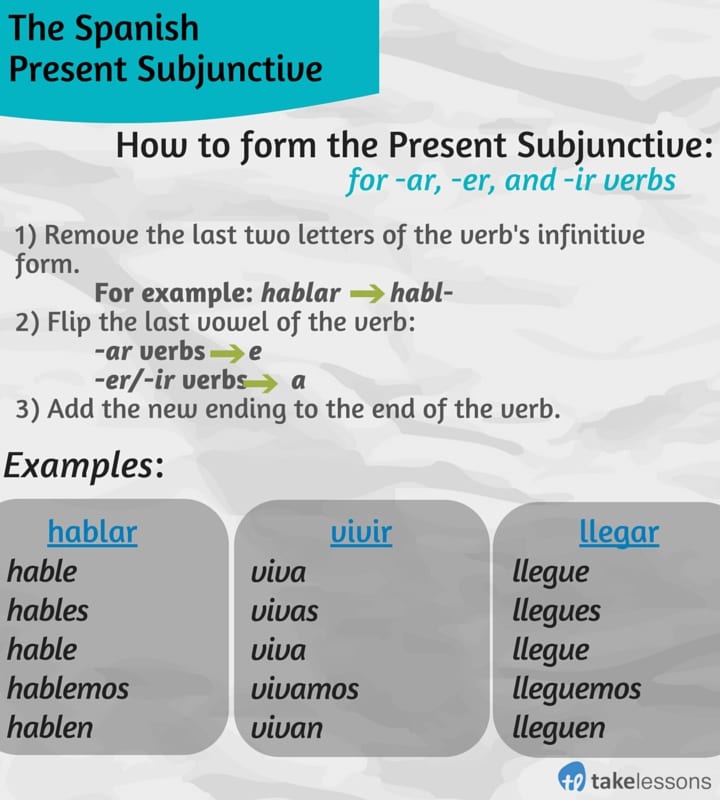You’ve learned about how to conjugate verbs in Spanish, and have a basic command of the language. Next up? Understanding the subjunctive mood! Read on as tutor Jason N. explains…
As you’re learning Spanish, it’s a smart idea to keep track of your progress. Your teacher or tutor can help you with this; if you’re learning on your own, try testing your Spanish here.
So, what’s next once you can communicate the basics comfortably and confidently? Advanced students who want to take their knowledge beyond basic communication can now begin learning about the Spanish subjunctive, usually taught in the third, fourth, or fifth year in schools or universities. To speak Spanish well, knowing when to use Spanish subjunctive is indispensable.
Why the Subjunctive is Important to Learn
- It’s ubiquitous in the language.
- Using it makes you sound like you really know how to speak Spanish competently.
- It enables you to tune into and express beautiful subtleties of the language that aren’t so clear or simply don’t exist in English.
- It allows you to express your point or opinion with more specificity.
- It has been referred to as a key indicator that distinguishes a fluent speaker who merely “gets by” learning the language from one who speaks it well.
- You cannot speak as proficiently as native Spanish speakers without learning it.
So, What is the Spanish Subjunctive?
Although it’s commonly referred to as the subjunctive tense in Spanish, it’s actually more of a mood, which acts as a category of tenses. You’ll know when to use Spanish subjunctive when you’re trying to imply an uncertainty about a given situation (more on this below).
Conjugating Subjunctive in Spanish
Conjugating the subjunctive is similar to forming formal commands in Spanish. The steps are outlined below:
Additional Examples
To clarify and provide a reference point, let’s compare subjunctive verbs Spanish conjugation to present indicative (normal) verb conjugation. Here are some key examples:
hablar (to talk)
Here’s another example with the slightly irregular verb llegar, meaning ‘to arrive.’ Here the a turns into ue, instead of just e. (See my previous post on Spanish stem-changing verbs to clarify this.)
llegar (to arrive)
When to Use the Present Subjunctive
Llegar will be the example used throughout the following 10 key contexts for using the present subjunctive tense Spanish.
Context #1: When the subordinate clause has elements that express doubt or negation
- Es difícil que lleguen a tiempo. (It’s hard for them to arrive on time.)
- No creo que lleguen a tiempo. (I don’t think they’ll arrive on time.)
- Dudo que lleguen a tiempo. (I doubt they’ll arrive on time.)
Context #2: When the subordinate clause has elements that express desire, fear, judgment, or other emotions/feelings
- Ojalá/espero que lleguen a tiempo. (I hope they arrive on time.)
- Temo que lleguen a tiempo. (I’m scared they will arrive on time.)
- Es triste que lleguen a tiempo. (It’s sad they arrive on time.)
- Estoy feliz de que lleguen a tiempo. (I’m happy they arrive on time.)
- ¡Qué bueno que lleguen a tiempo! (It’s good they arrive on time!)
- Quisiera que llegaran a tiempo. (I would like them to arrive on time.)
- Es raro/extraño que lleguen a tiempo. (It’s odd they arrive on time.)
Context #3: When the subordinate clause has elements that express possibility
Note: Many competent Spanish-speakers don’t employ the subjunctive in these contexts to consciously or unconsciously communicate less doubt in the possibility.
Context #4: When the subordinate clause has elements that express need
- Es necesario que lleguen a tiempo. (It’s necessary they arrive on time.)
- Necesito que lleguen a tiempo. (I need them to arrive on time.)
- Es preciso que lleguen a tiempo. (It’s essential they arrive on time.)
Context #5: When the subordinate clause has elements that express an expected pattern
- Es normal que lleguen a tiempo. (It’s normal that they arrive on time.)
- Es lógico que lleguen a tiempo. (It’s logical that they arrive on time.)
- Es frecuente que lleguen a tiempo. (It’s frequent they arrive on time.)
- Es razonable que lleguen a tiempo. (It’s reasonable they arrive on time.)
Context #6: When the subordinate clause has elements that express specificity
- Quiero una novia que sea guapa. (I want a girlfriend who is pretty.)
Context #7: When the subordinate clause refers to a past event before it occurred [past subjunctive]
- Ya supe eso antes de que viniera Juan. (I knew that before Juan arrived.)
Context #8: When the subordinate clause introduces depends on the main clause
- Eso depende de qué hora lleguen. (That depends on what time they arrive.)
Context #9: When the subordinate clause directly causes or affects the main clause
- El clima hace que no lleguen a tiempo. (The weather makes them not arrive on time.)
- El clima permite que lleguen a tiempo. (The weather allows them to arrive on time.)
Context #10: In some cases, when the subordinate clause introduces a fact
- El hecho de que lleguen a tiempo significa que son punctual.
(The fact that they arrive on time means they are punctual.)
It’s important to note that there are other important contexts where the subjunctive mood is employed that I didn’t mention here. Also, the subjunctive follows a whole new set of rules in the past tense (i.e. the past subjunctive). My goal here was to highlight the most common contexts for using the present subjunctive. Interested in how to master Spanish subjunctive a Spanish tutor can really help with this tricky yet indispensable aspect of the language. If you’ve learned the Spanish subjunctive, you clearly know your Spanish!
 Post Author: Jason N.
Post Author: Jason N.Jason N. tutors in English and Spanish in Fairfax, CA. He majored in Spanish at UC Davis, lived in Mexico for 3 years where he completed a Master’s degree in Counseling, and studied Spanish Literature and Psychology at the University of Costa Rica. Learn more about Jason here!
Photo by Bill Dickinson
Suzy S.






